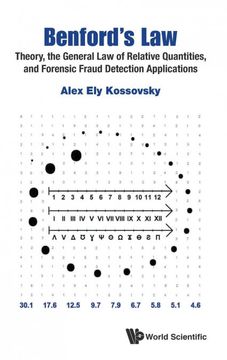Benford's Law: Theory, the General law of Relative Quantities, and Forensic Fraud Detection Applications (en Inglés)
Reseña del libro "Benford's Law: Theory, the General law of Relative Quantities, and Forensic Fraud Detection Applications (en Inglés)"
Contrary to common intuition that all digits should occur randomly with equal chances within numbers in real data, empirical examinations consistently show that not all digits are created equal, but rather that low digits such as {1, 2, 3} occur much more frequently than high digits such as {7, 8, 9} in almost all data types, such as those relating to geology, chemistry, astronomy, physics, and engineering, as well as in accounting, financial, econometrics, and demographics data sets. This intriguing digital phenomenon is known as Benford's Law, and it constitutes the only multidisciplinary mathematical pattern occurring throughout all the sciences. This book gives a comprehensive and in-depth account of all the theoretical aspects, results, causes and explanations of Benford's Law, with a strong emphasis on the connection to real-life data and the physical manifestation of the law, and can serve as a reference as well as a text for courses. The clear exposition, parables facilitating intuition, and focus on visual representations, make for easy, enlightening, and entertaining reading. In addition to such bird´s eye view of the digital phenomenon, the conceptual distinctions between digits, numbers, and quantities are explored; leading to the key finding that the phenomenon is essentially quantitative and physical, not merely digital and numerical, constituting a scientific reality independent of our arbitrarily invented positional number system; originating from the fact that in extreme generality, nature creates many small quantities but very few big ones, corroborating the motto "small is beautiful". Such an unorthodox point of view is mathematically worked out in the book via the postulate that the generic pattern in how relative quantities are found in nature is such that the frequency of quantitative occurrences is inversely proportional to quantity, leading to what is termed 'The General Law of Relative Quantities', expressed algebraically as ln((D+d(F-1))/(D+(d-1)(F-1)))/ln(F). When real-life data sets are checked against this expression they are found to be in agreement with it, corroborating this rather radical interpretation of the law and endowing scientific credibility to the entire work. Classic Benford's Law regarding the first order distribution of our numerical digits, namely LOG(1+1/d), is then demonstrated to be merely a consequence and a special case of this more general law. Fraudsters are typically not aware of this digital pattern and tend to invent numbers with approximately equal digital frequencies. The digital analyst can easily check reported data for compliance with this digital law, enabling the detection of tax evasion, Ponzi schemes, and other financial scams. The forensic fraud detection section in this book is written in a very concise and reader-friendly style; gathering all known methods and standards in the accounting and auditing industry; summarizing and fusing them into a singular coherent whole; and can be understood without deep knowledge in statistical theory or advanced mathematics. In addition, a digital algorithm is presented, enabling the auditor to detect fraud even when the sophisticated cheater is aware of the law and invents numbers accordingly. The algorithm employs a subtle inner digital pattern within the Benford's pattern itself. This newly discovered pattern is deemed to be nearly universal, being even more prevalent than the Benford phenomenon, as it is found in all random data sets, Benford as well as non-Benford types.

